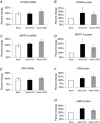Effect of resistance exercise contraction mode and protein supplementation on members of the STARS signalling pathway
- PMID: 23753523
- PMCID: PMC3752455
- DOI: 10.1113/jphysiol.2012.249755
Effect of resistance exercise contraction mode and protein supplementation on members of the STARS signalling pathway
Abstract
The striated muscle activator of Rho signalling (STARS) pathway is suggested to provide a link between external stress responses and transcriptional regulation in muscle. However, the sensitivity of STARS signalling to different mechanical stresses has not been investigated. In a comparative study, we examined the regulation of the STARS signalling pathway in response to unilateral resistance exercise performed as either eccentric (ECC) or concentric (CONC) contractions as well as prolonged training; with and without whey protein supplementation. Skeletal muscle STARS, myocardian-related transcription factor-A (MRTF-A) and serum response factor (SRF) mRNA and protein, as well as muscle cross-sectional area and maximal voluntary contraction, were measured. A single-bout of exercise produced increases in STARS and SRF mRNA and decreases in MRTF-A mRNA with both ECC and CONC exercise, but with an enhanced response occurring following ECC exercise. A 31% increase in STARS protein was observed exclusively after CONC exercise (P < 0.001), while pSRF protein levels increased similarly by 48% with both CONC and ECC exercise (P < 0.001). Prolonged ECC and CONC training equally stimulated muscle hypertrophy and produced increases in MRTF-A protein of 125% and 99%, respectively (P < 0.001). No changes occurred for total SRF protein. There was no effect of whey protein supplementation. These results show that resistance exercise provides an acute stimulation of the STARS pathway that is contraction mode dependent. The responses to acute exercise were more pronounced than responses to accumulated training, suggesting that STARS signalling is primarily involved in the initial phase of exercise-induced muscle adaptations.
Figures






References
-
- Andersen LL, Tufekovic G, Zebis MK, Crameri RM, Verlaan G, Kjaer M, Suetta C, Magnusson P, Aagaard P. The effect of resistance training combined with timed ingestion of protein on muscle fibre size and muscle strength. Metabolism. 2005;54:151–156. - PubMed
-
- Arai A, Spencer JA, Olson EN. STARS, a striated muscle activator of Rho signalling and serum response factor-dependent transcription. J Biol Chem. 2002;277:24453–24459. - PubMed
-
- Bassel-Duby R, Olson EN. Signaling pathways in skeletal muscle remodeling. Annu Rev Biochem. 2006;75:19–37. - PubMed
Publication types
MeSH terms
Substances
LinkOut - more resources
Full Text Sources
Other Literature Sources
Medical
Miscellaneous

